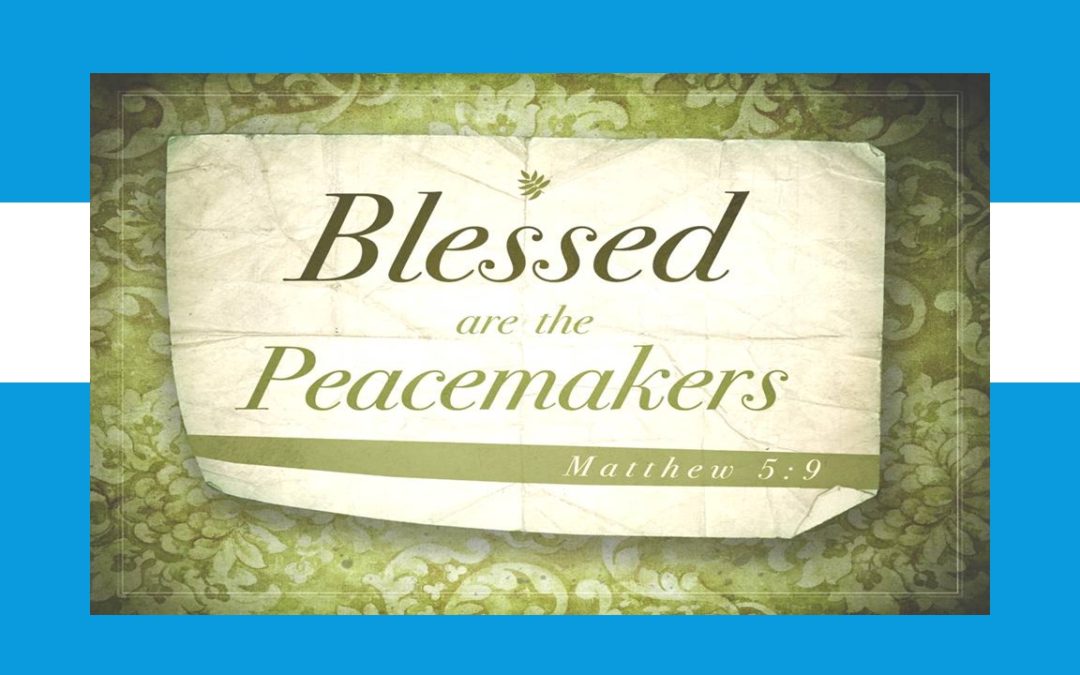The first day of every year is, for us Christians, the Solemnity of the Motherhood of Mary and International Day of Peace. I wish to share with you, the Message of Pope Francis.
    On January 1, 1968 Blessed Pope Paul VI inaugurated the year with the First Message of the World Day of Peace on The Day of Peace. On January 1, 2017 Pope Francis continued the fruitful tradition by celebrating the Fiftieth World Day of Peace with a powerful message entitled Nonviolence as a Style of Politics for Peace. Hereafter, I wish to present and reflect on this wonderful invitation of Pope Francis to all to be peacemakers through nonviolence.
    Why did Pope Francis select nonviolence as a peaceful style of life? Because violence continues to abound in our hearts and in our world. Unfortunately, we live in a “broken world,†in a “horrifying world†where war is fought piecemeal. Pope Francis cries out that there is “piecemeal violence†of different kinds and levels: “War in different countries and continents; terrorism, organized crime and unforeseen acts of violence; and the devastation of the environment†(2017 Message 1). There are weapon traffickers, and vast amounts of resources are spent for weapons of war while young and old people suffer terrible hardships. In our world, there are domestic violence and abuse of women and children (nos. 2, 4, 5).
    How may we fight violence nonviolently? Violence is fought and healed not by more violence but by active nonviolence.  Active nonviolence does not mean surrender, or lack of social involvement, or passivity. It overcomes the temptation to retaliate. Active nonviolence is a quality of authentic human and Christian love, which presupposes justice and respects truth.
    How to achieve fuller and wider peace in our world? Our common humanity and our faith command us to be peacemakers. One starts by acquiring internal and external personal peace. To be instruments of peace, we have to banish violence “from our hearts, words and deeds†(no. 7). We work for social peace by practicing equality, love and solidarity; by witnessing and promoting integral ecology, which means human dignity and rights, freedom, justice, truth and peace, and the integrity of creation.
    Is it hard to be peacemakers in our families, in our communities, in our world? We have amazing models to follow. Jesus, the model, proclaims nonviolence by his life and message. He walks the path of loving nonviolence “to the very end, to the cross, where he became our peace and put an end to hostility†(3). He preaches the unconditional love he lives, a love which shares with the needy and forgives all, including enemies. The Gospel of Jesus focuses on the Sermon on the Mount and the Good News of nonviolent love, on the eight Beatitudes: Blessed are the meek, the merciful, the peacemakers…
    Pope Francis mentions other well-known models of active nonviolence: St. Francis, St. Therese of the Child Jesus, and Saint Mother Teresa of Kolkata; Gandhi, Martin Luther King Jr, Leymah Gbowee and women. Pope Francis underlines the essential role of the family in promoting peace and nonviolence: “An ethics of fraternity and peaceful coexistence†starts in the family. All religions contribute to peace in the world. Pope Francis says that “no religion is terrorist, peace alone is holy, not war.â€
    The Pope from Argentina recalls the example of St. Therese and invites us to practice her “little way of love, not to miss out on a kind word, a smile or any small gesture which sows peace and friendship†(5). He brings to our attention the example and words of Saint Mother Teresa who says: “We in our family don’t need bombs and guns to destroy, to bring peace – just get together, love one another… And we will be able to overcome all the evil that is in the world†(3). Indeed, there is no way to peace, peace is the way (Gandhi). Hence, “We adopt the means of nonviolence because our end is a community at peace with itself†(Martin Luther King Jr).
    Pope Francis points out the forceful messages on loving and peaceful nonviolence of popes Paul VI, John Paul II and Benedict XVI. Who does not remember the piercing words of Blessed Paul VI at the United Nations in New York (October 4, 1965): “No more war! War never again! It is peace which must guide the destinies of peoples and of all mankind.†St. John Paul II proclaims: “Justice and forgiveness are essential to healingâ€; “May people learn to fight for justice without violence, renouncing class struggle in their internal disputes and war in international ones†(no. 4). Pope Francis quotes from the teachings about nonviolence of Pope Benedict XVI, who says:“For Christians, nonviolence is not merely tactical behavior but a person’s way of being, the attitude of one who is convinced of God’s love and power that he or she is not afraid to tackle evil with weapons of love and truth alone. Love of one’s enemies constitutes the nucleus of the Christian revolution†(3). I remember well the powerful statement of the Philippine Bishops just a few days before the EDSA peaceful revolution: “We insist, our acting must always be according to the Gospel of Christ, that is, in a peaceful, nonviolent way†(CBCP, February 14, 1986).
    In his fourth Message for the World Day of Peace (2017), Pope Francis makes a strong plea: “I plead for disarmament and for the prohibition and abolition of nuclear weapons.†The Pope adds: “Nuclear deterrence and the threat of mutual assured destruction are incapable of grounding†an ethics of “fraternity and peaceful coexistence between individuals and among peoples.†This ethics “cannot be based on the logic of fear, violence and closed-mindedness, but on responsibility, respect and sincere dialogue†(5).
    Active violence is also creative nonviolence: it actively creates new ways and methods and activities to achieve peace nonviolently in different situations and places. The world-wide movement of nonviolence relies radically on a deep spirituality which helps nonviolent peacemakers answer nonviolently any provocation. Nonviolence, a product of justice, truth and love is also, Pope Francis tells us, prayerful nonviolence: “Nothing is impossible if we turn to God in prayer. Everyone can be an artisan of peace†(7). The reigning Pope stresses the need of prayer to witness nonviolence in our life, to make nonviolent love the style of life.
    We celebrate today the Motherhood of Mary: Mary, the Mother of God. This is how she is called through the first centuries of Christianity. Mary is the Mother of Jesus, who is the Son of God and the Son of Mary: “She conceived, brought forth and nourished Christ; presented Him to the Father in the temple, and was united with Him in suffering as He died on the cross†(LG, 61). Mary is, certainly, the Mother of the Child Jesus, and also the Mother of the Crucified and Risen Lord. May Mary, the Mother of God and our Mother, the Queen of Peace (Regina pacis) help us all be committed to peace in our world – a world that longs for peace here, there and everywhere!
    In closing, two inspiring texts that come to mind: First keep yourself in peace and then shall you be abler to bring others to peace (Kempis). Acquire inner peace and thousands around you will find liberation (St. Seraphim).
(Fausto Gomez OP, Jan 1, 2017)

